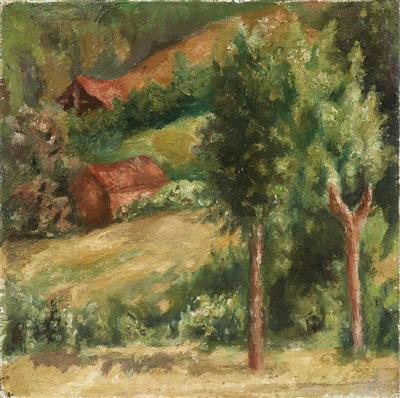Giorgio Morandi *

(Bologna 1890–1964)
Paesaggio, 1927, signed on the reverse, oil on canvas, 18 x 18 cm, framed
Provenance:
A. Bonora Collection, Florence
Galleria d’Arte Falsetti, Prato (stamp on the reverse)
Franco Fabbi Collection, Modena
Finarte, Milan, 16 June 1998, lot 311b
European Private Collection
Exhibited:
Ferrara, Palazzo dei Diamanti, Giorgio Morandi, 1 July–8 October 1978, exh. cat. (label on the reverse)
Madrid, Fundacion caja de pensiones, Giorgio Morandi 1890–1964,
11 December 1984 – 28 January 1985, exh. cat. (stamp on the reverse)
Marseille, Musée Cantini, Giorgio Morandi, 13 April – 18 June 1985, exh. cat. (label on the reverse)
Bologna, Galleria comunale d’arte moderna, Giorgio Morandi 1890 – 1990, centenary exhibition, 12 May – 2 September 1990, exh. cat. (label on the reverse)
Literature:
L. Vitali, Morandi. Catalogo generale. Volume primo 1913–1947, Electa Editrice, Milan 1983, no. 123 with ill.
Giorgio Morandi was a tireless investigator of reality: his existence, so far removed from the stereotype of the bohemian artist, was completely devoted to painting.
His routine and his affections were concentrated within the walls of the house in Via Fondazza, Bologna, which he shared with his sisters.
The quantity and quality of information that Morandi could have accessed in his voluntary self-isolation has been much discussed: in the past, some critics have tended to underplay the level of his artistic knowledge, emphasising the cultural paucity of his environment, as if his “not knowing” made him somehow greater.
In reality, although he lived most of his life in Bologna, Morandi possessed an intellectual curiosity that led him to both learn about the artistic works and trends around him and also to reappraise the great artists of the past, such as Giotto, Masaccio, Piero della Francesca and Paolo Uccello, who would become an indelible part of his artistic development. Love for the French tradition is clear in his choice of modern artists, evidenced by his lifelong interest in Chardin’s famous “still lifes” and Corot, whose pictorial influence is demonstrable in certain landscapes from the 1920s, such as the one presented here. Cezanne was the closest artist to Morandi chronologically and spiritually, with his impressive retrospective at the Venice Biennale in 1920 (at the very moment when the European trend of the “call to order” was most widespread) and his rejection of the most superficial and picturesque emotions in his “passionate denial of light (the fixation and myth of the Impressionists) in favour of colour and form.”
However, Morandi also had the opportunity to deepen his knowledge of Impressionism through Ardengo Soffici’s articles and accompanying
photographs in “La Voce”. In all probability, he had also seen Renoir’s great exhibition at the Venice
Biennale; it is possible that Courbet’s work, presented by Ugo Ojetti, was also relevant.
Finally, Morandi’s journey also contains tangential connections to Picasso, Braque and Derain’s Cubism, a language with which he experimented between 1914 and 1915, and which he referenced in certain “Landscapes” of the 1930s. He was, however careful to avoid betraying the visible in favour of forced aestheticism or decorative spirit.
The 1927 “Landscape” presented here is a complete and thorough work within the wider corpus of Morandi’s landscape paintings.
At the time of painting, Morandi was close to 40 years old: „after the curiosity in, if not the enthusiasm for, the avant-garde at the turn of the century, and after the positive but not entirely linear relationship with Mario Broglio and the ‘Valori Plastici’, it is now time for him to develop ever greater powers of introspection to focus on and to fix his own image, relying less and less on external stimuli and references and digging within to sustain and define itself as a work” (Marilena Pasquali in “Morandi e il suo tempo”, p. 54).
This process of decanting and loss of the superfluous produces a severe landscape with a strong structure.Characterised by two naturalistic trees in the foreground (Corot) and light that seems to move the branches and leaves (an anomalous legacy of Renoir’s Impressionist palette).
The two parallelepiped houses, synthetic prisms echoing Cezanne and Cubism, are immersed in the landscape and lost in the background.
The entire composition maintains a remarkable balance and confidence in colour choice, this tonalism uniting the whole. As sometimes occurs in Morandi’s landscapes, the sky is absent (or minimally present), perhaps because it has no structural function within the painting, whose layout is related to the “frame” of the canvas.
This work speaks to Morandi’s capability as a great landscape artist who has assimilated, reworked, and made the lessons of the past his own.
Curiously, many of Morandi’s landscapes were not painted en plein air, but through a telescope in the window of his house in Grizzana, in the Bolognese Apennines.
Esperto: Alessandro Rizzi
 Alessandro Rizzi
Alessandro Rizzi
+39-02-303 52 41
alessandro.rizzi@dorotheum.it
23.06.2020 - 16:00
- Prezzo realizzato: **
-
EUR 119.050,-
- Stima:
-
EUR 90.000,- a EUR 120.000,-
Giorgio Morandi *
(Bologna 1890–1964)
Paesaggio, 1927, signed on the reverse, oil on canvas, 18 x 18 cm, framed
Provenance:
A. Bonora Collection, Florence
Galleria d’Arte Falsetti, Prato (stamp on the reverse)
Franco Fabbi Collection, Modena
Finarte, Milan, 16 June 1998, lot 311b
European Private Collection
Exhibited:
Ferrara, Palazzo dei Diamanti, Giorgio Morandi, 1 July–8 October 1978, exh. cat. (label on the reverse)
Madrid, Fundacion caja de pensiones, Giorgio Morandi 1890–1964,
11 December 1984 – 28 January 1985, exh. cat. (stamp on the reverse)
Marseille, Musée Cantini, Giorgio Morandi, 13 April – 18 June 1985, exh. cat. (label on the reverse)
Bologna, Galleria comunale d’arte moderna, Giorgio Morandi 1890 – 1990, centenary exhibition, 12 May – 2 September 1990, exh. cat. (label on the reverse)
Literature:
L. Vitali, Morandi. Catalogo generale. Volume primo 1913–1947, Electa Editrice, Milan 1983, no. 123 with ill.
Giorgio Morandi was a tireless investigator of reality: his existence, so far removed from the stereotype of the bohemian artist, was completely devoted to painting.
His routine and his affections were concentrated within the walls of the house in Via Fondazza, Bologna, which he shared with his sisters.
The quantity and quality of information that Morandi could have accessed in his voluntary self-isolation has been much discussed: in the past, some critics have tended to underplay the level of his artistic knowledge, emphasising the cultural paucity of his environment, as if his “not knowing” made him somehow greater.
In reality, although he lived most of his life in Bologna, Morandi possessed an intellectual curiosity that led him to both learn about the artistic works and trends around him and also to reappraise the great artists of the past, such as Giotto, Masaccio, Piero della Francesca and Paolo Uccello, who would become an indelible part of his artistic development. Love for the French tradition is clear in his choice of modern artists, evidenced by his lifelong interest in Chardin’s famous “still lifes” and Corot, whose pictorial influence is demonstrable in certain landscapes from the 1920s, such as the one presented here. Cezanne was the closest artist to Morandi chronologically and spiritually, with his impressive retrospective at the Venice Biennale in 1920 (at the very moment when the European trend of the “call to order” was most widespread) and his rejection of the most superficial and picturesque emotions in his “passionate denial of light (the fixation and myth of the Impressionists) in favour of colour and form.”
However, Morandi also had the opportunity to deepen his knowledge of Impressionism through Ardengo Soffici’s articles and accompanying
photographs in “La Voce”. In all probability, he had also seen Renoir’s great exhibition at the Venice
Biennale; it is possible that Courbet’s work, presented by Ugo Ojetti, was also relevant.
Finally, Morandi’s journey also contains tangential connections to Picasso, Braque and Derain’s Cubism, a language with which he experimented between 1914 and 1915, and which he referenced in certain “Landscapes” of the 1930s. He was, however careful to avoid betraying the visible in favour of forced aestheticism or decorative spirit.
The 1927 “Landscape” presented here is a complete and thorough work within the wider corpus of Morandi’s landscape paintings.
At the time of painting, Morandi was close to 40 years old: „after the curiosity in, if not the enthusiasm for, the avant-garde at the turn of the century, and after the positive but not entirely linear relationship with Mario Broglio and the ‘Valori Plastici’, it is now time for him to develop ever greater powers of introspection to focus on and to fix his own image, relying less and less on external stimuli and references and digging within to sustain and define itself as a work” (Marilena Pasquali in “Morandi e il suo tempo”, p. 54).
This process of decanting and loss of the superfluous produces a severe landscape with a strong structure.Characterised by two naturalistic trees in the foreground (Corot) and light that seems to move the branches and leaves (an anomalous legacy of Renoir’s Impressionist palette).
The two parallelepiped houses, synthetic prisms echoing Cezanne and Cubism, are immersed in the landscape and lost in the background.
The entire composition maintains a remarkable balance and confidence in colour choice, this tonalism uniting the whole. As sometimes occurs in Morandi’s landscapes, the sky is absent (or minimally present), perhaps because it has no structural function within the painting, whose layout is related to the “frame” of the canvas.
This work speaks to Morandi’s capability as a great landscape artist who has assimilated, reworked, and made the lessons of the past his own.
Curiously, many of Morandi’s landscapes were not painted en plein air, but through a telescope in the window of his house in Grizzana, in the Bolognese Apennines.
Esperto: Alessandro Rizzi
 Alessandro Rizzi
Alessandro Rizzi
+39-02-303 52 41
alessandro.rizzi@dorotheum.it
|
Hotline dell'acquirente
lun-ven: 10.00 - 17.00
kundendienst@dorotheum.at +43 1 515 60 200 |
| Asta: | Arte moderna |
| Tipo d'asta: | Asta in sala |
| Data: | 23.06.2020 - 16:00 |
| Luogo dell'asta: | Wien | Palais Dorotheum |
| Esposizione: | 18.06. - 23.06.2020 |
** Prezzo d’acquisto comprensivo dei diritti d’asta acquirente e IVA
Non è più possibile effettuare un ordine di acquisto su Internet. L'asta è in preparazione o è già stata eseguita.
